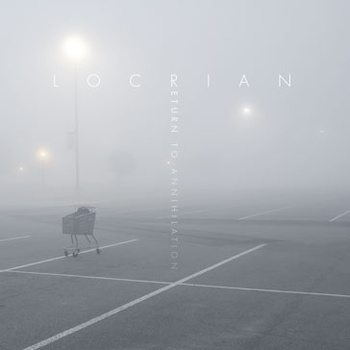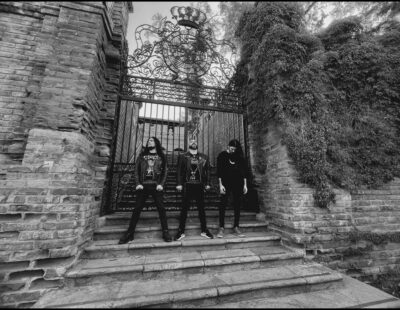The new Locrian record Return to Annihilation is out today and — perhaps predictably — it’s fucking awesome and epic and enthralling and, yeah, maybe a little nutty. Go hear for yourself here, buy it here, and check out the band’s exclusive track-by-track listening guide below.
1. Eternal Return
We wanted to start out the record with something that was different and unexpected from what people might think they’d hear when they drop the needle or push play on the new record. We had this idea from listening to King Crimson’s album In the Wake of Poseidon that has those shorter pieces titled “Peace.” We wanted to challenge certain expectations and try and make something that was shorter and more melodic. Also thinking about The Cure’s Disintegration how it has a brief chiming intro before it just falls into this heavy opener. We knew it was the first track because of its melody, and brevity — plus it introduces the main themes of the record and acts as more of a literary forward for the entire record; which is that of humanity vanishing and the earth transforming itself into this inhospitable place. As for the song structure, we wanted to challenge ourselves by writing a song that was under four minutes but still capturing our sound and style of our song writing. It’s really different from anything else that we’ve done in the past — a statement that we’re evolving as musicians, as people, and as a group.
2. A Visitation from the Wrath of Heaven
This piece really takes the mood to another place; from the highs of “Eternal Return” the low end comes in, just a nice throb. In the narrative of the record we wanted there to have some stability established that then gets broken at the end. Steven did this really interesting thing with his snare, where he stacked a hi-hat cymbal and a small broken splash cymbal on his snare head and struck those, creating a kind of distorted synth drum effect, along with the tribalistic or industrial feel of the rhythm it really accentuate the overall feel, then it explodes into the end, which really is like the beginning of the cataclysm, with an ominous choir and all. There is a story being told here, and for the first two-thirds of the track it’s the calm before the storm, then everything changes and gets turned upside down.
It should be noted that this track would best be experienced through earphones. We did some strange random panning of the guitar on it and it gives the track a really strange unbalanced feel to it.
André had this great riff before we recorded — he’s really into Bert Jansch, Ronnie Basho and that spindly guitar finger work — it’s quite beautiful and melancholic, something of a mix between Nick Drake, Fahey, and Derek Bailey. So we made a nod in the title to Nick Drake’s Pink Moon, but also to one of our literary influences — Samuel Delaney’s sci-fi novel Dhalgren. Two moons appear in the sky after this environmental cataclysm — the ‘visitation from the wrath of heaven.’ A lot of what we want to do is create spaces, like chapters in the story. But also give the listener some space and this piece was definitely something to bridge between the bombast of “Visitation” and the almost claustrophobic intro to the title track. We were also trying to find a perfect juxtaposition between acoustic instruments and electronic instruments and we think this track sums that up nicely.
4. Return to Annihilation
A. Into One Light
André and Steven came up with the basic structure for the music here, just great repetitive chiming guitars and really driving drums. It kind of has an intense minimal, repetitive, and aggressive kind of attitude. This whole suite of songs really is about the character that is observing the earth undergoing this change, becoming full of crystal, mirrors and fogs. Something that refracts and obscures the veracity of the events. Terence also sings on this movement in the track, which has this nice space to it to chant again about the sublimity of our destruction.
B. Anathemata
The “Return” in the album’s title is also this return we wanted to do with our past records. So here we wanted to refract the “Plague Journal” 7-inch we did, and use it as a bridge between these two very different parts. The title for this movement is also a reference to Delaney’s Dhalgren, the final chapter which ends abruptly and actually circles to the first sentence of the beginning of the novel. This circularity was really important to us in these themes of the new record.
C. All Mineral in Upheaval
Probably the most metal moment, it has some nice time changes in it too. Terence used a great Mellotron that was at Electrical Audio for some accents at the end. Andre had this beautiful riff in here too. This is where the story could end, the vocals speak of the minerals revolting, our monuments vanishing but also confessing a state of noctambulism. Perhaps it is this sleepwalking that brought us to this point of collapse.
5. Exiting the Hall of Vapor and Light
This begins the second part of the album, which is a reflection through a prism of the first of the album. A state of emergence, from these halls where again the sense of what is happening is obscured. Terence also got to use an EDP Wasp synth that was really popular with early industrial groups like Throbbing Gristle and Whitehouse. It’s just this noisy toy but some great sounds were created from of it. Apparently a lot of people hated that it would just play even when you stopped touching it but we used its unpredictability for something really unique — a nice mellow haze of synth drones.
6. Panorama of Mirror
Similarly to the two moons appearing from the first part of the album here the entire landscape is mirror. This is also perhaps the noisiest moment on the album. It was intentional. Terence: “I was really thinking about stuff like early Broken Flag records, just that early period of power-electronics walls of feedback.” We bury these but allow them to emerge at certain points before the guitars and broken/fragmented drums takeover. For this track we also dove back into The Crystal World record, extracting, revisiting, and reworking rhythmic and improvisational interaction that we though would work well on the new record.
7. Obsolete Elegies
A. Isostasy
The track is a return to the theme that was on our Drenched Lands album. Obviously, it came out very differently than on our first album which was the point, we don’t want to fucking repeat ourselves, only grab small elements of past songs which we thought would fit well into what we were creating for Return to Annihilation.
A lot of what we are interested in are textures and this whole suite of tracks really reflect that narrative arc. So Terence did a track of sounds from inside the piano — actually crawling in and scraping the piano stringS — and then recorded some small phrases, to go along with André’s guitar.
Here, too, the lyrics set this tense scene of the geologic transformation.
B. Digression of Air
This piece is probably the most prog moment in the song, Terence really wanted to use the Mellotron, and he ran it through another tape delay for added effect. The Mellotron is just a beautiful instrument, super unique when you let it do what it does. Again it pulls a lot from our love of early Emerson Lake and Palmer and King Crimson…a bit. It’s still ours even though we had some strong influences. André: “We knew we wanted to do some new things on the album so I decided I would work in a guitar solo for this section of the song, which was very influenced by Steve Hackett.”
c. Hydiotaphia
Hydriotaphia is the burial of urns. This title was ripped from a great work by Sir Thomas Browne from the 17th century. It was a big influence on Jorge Luis Borges. It focuses on death and funerary practices and really is about melancholy. What else is there when faced with destruction but the preparations for the inevitability of death? This track returns back to the ending of “Elevations and Depths” off The Crystal World. At this point in the piece we really let things simmer in the music, again switching textures and bring in more piano and violins, guitar drones to build into the fourth part.
D. In Felsic Splendor
The last lyric was a quote from a letter of Karl Marx about “awakening the world from a dream of itself.” So we think that happens here on this track, if you think about the end of Part I admitting to a state of noctambulism. Here we end with the desire to awaken. Again these are darkened mirrors of each other. An admission of sleepwalking and the desire to awaken to regain some sort of control. Much like the title track this is also a more direct and aggressive moment for us, this time we work with some more black metal riffs and structure before finally heading into the final melodic passage, which is our epic finale. André does some slick guitar harmonizing and solos in the last couple min, and Steven used an old Simmons SDS1 drum synth from the 80’s to add these explosive accents. A great way to end the record!








